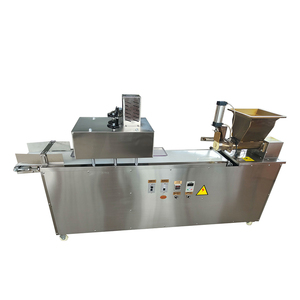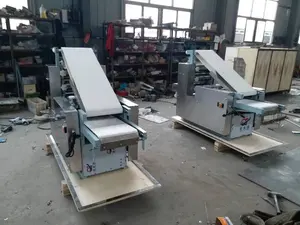(13549 products available)








































































































































































































A pizza production line is a type of machinery that is designed to automate the process of making pizzas on a commercial scale. It is crucial for business buyers to understand that there are many different types of pizza production lines, which are generally used for different types of pizza. Some of the most popular pizza production lines include:
This type of pizza production line typically begins with a conveyor belt that transports the pizza crust to an assembly station. At this station, various toppings are added to the pizza, which can include sauce, cheese, meats, and vegetables. Once the toppings have been added, the pizza moves through a baking or cooking station where it is cooked. Finally, the pizza is sliced and boxed for distribution.
This type of pizza production line is similar to the pre-made crust assembly line, with the key difference being that the crust is frozen. The frozen crust is typically placed on a conveyor belt that moves it through a topping application station. Once the toppings have been added, the pizza is flash-frozen and packaged for distribution.
This type of pizza production line is typically more customizable and allows for greater flexibility in the types of pizzas that can be produced. The line is usually made up of different modules that can be added or removed depending on the desired outcome. For example, the line may include a module for pressing out pizza dough, a module for adding toppings, and a module for baking the pizza.
This type of pizza production line focuses on the baking process. It typically consists of a long conveyor belt that moves pizzas through a high-temperature oven. The oven is often designed to cook pizzas quickly and evenly. Once the pizzas are cooked, they are typically sliced and boxed for distribution.
Specifications and components of a pizza production line are critical to its maintenance. The main components of the machine include the dough mixer, dough roller/press, sauce applicator, cheese and topping applicator, baking/oven system, and cooling and packaging system.
The maintenance of the pizza production line machine requires regular inspection, cleaning, and lubrication. The machine's user manual may have guidance on routine inspections and maintenance tasks. It is important to ensure that parts that require to be replaced after a certain period are looked at. Maintenance for the replacement parts is also crucial in preventing the machine from breaking down. The machine's components, such as the chains, conveyors, and cutting mechanisms, should be properly lubricated with food-grade lubricants to avoid contamination.
Cleaning is an important maintenance routine for a pizza production line to ensure that food residue is not left on the machine, which can cause bacterial growth.
Production line systems for pizzas are commonly used in pizzerias, food processing plants, restaurants, and bakeries. However, the usage of these production lines is not limited to the above-mentioned places. A pizza production line can be used in a wide range of business scenarios.
These facilities produce frozen pizzas in bulk for retail stores, food service providers, and other commercial customers. Production lines help streamline the process, increase efficiency, and maintain consistent quality.
These facilities supply pre-made pizzas to satellite locations, such as school cafeterias, hospitals, and airport concessions. Production lines enable them to meet the demand for large quantities while controlling costs.
Franchise chains with multiple locations use production lines to ensure uniformity across their establishments. The production lines also simplify the training of staff.
Although production lines are more commonly associated with large-scale operations, some small-scale food businesses also use them to increase efficiency and production capacity. For example, a specialty pizza shop that supplies frozen pizzas to local grocery stores may invest in a production line to scale up their business.
These virtual restaurants operate out of commercial kitchens and rely on delivery and takeout orders. Production lines enable them to quickly assemble and cook pizzas to meet the demand from online customers.
Mobile food businesses that participate in festivals, fairs, and other events may use portable pizza production lines in their trucks or trailers. The production lines help them serve a high volume of customers efficiently in a limited space.
As the pizza production line becomes more advanced and affordable, start-up businesses and entrepreneurs may also consider investing in this equipment. It enables them to launch their pizza-making venture with greater efficiency and scalability from the outset.
When selecting a pizza production line, it is important to perform an in-depth analysis of the market to understand the current trends, demands, and preferences of the target audience. Also, it is important to determine the scale and capacity requirements of the production line. Consider the current business needs, production volume, and growth projections. Ensure that the selected line can meet the required production capacity.
Before deciding which pizza production line to invest in, it is essential to make sure that the selected equipment is compatible with the existing production setup. It is also necessary to evaluate the entire production process and identify areas where automation can enhance efficiency and consistency, such as dough management, topping application, and packaging. Select equipment that can seamlessly integrate into the existing workflow and optimize the overall production.
When investing in a pizza production line, it is essential to consider the total cost of ownership, including initial investment, operating costs, and maintenance expenses. Choose equipment that offers a good return on investment by improving efficiency, reducing labor costs, and minimizing product wastage. Ensure that the selected production line is easy to operate and maintain. Proper training and after-sales support from the supplier can make a significant impact on the equipment's long-term performance.
It is important to choose a supplier with a good reputation and solid manufacturing experience. Research potential suppliers, read customer reviews, and ask for references to gain confidence in the supplier's reliability and equipment quality. Collaborate with the supplier to customize the production line according to specific requirements and ensure timely delivery and installation support. Finally, before making a final decision, it is important to request product demonstrations and samples to evaluate the equipment's performance and quality.
Q1: How are pizza production lines changing the pizza industry?
A1: Pizza production lines are streamlining the creation of pizzas, which will lead to faster processing times and a lower price point for customers.
Q2: What goes on at a pizza production line?
A2: At a pizza production line, dough is flattened, and other ingredients are added. Finally, the pizzas are cooked and packaged.
Q3: Can pizza production lines be customized?
A3: Yes, most pizza production lines can be customized to meet specific requirements. This includes everything from the machine's dimensions to the number of toppings that can be added to the pizza.
Q4: What are the benefits of pizza production lines?
A4: There are many benefits of using a pizza production line, including a higher production capacity, product consistency, more straightforward production processes, and labor savings. The benefits will be different depending on the specific needs of the business.